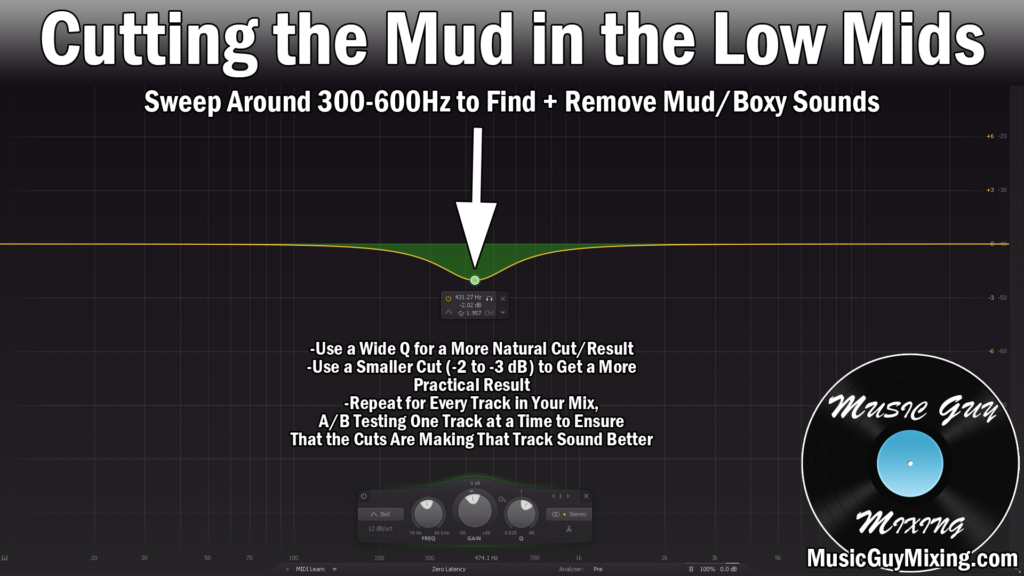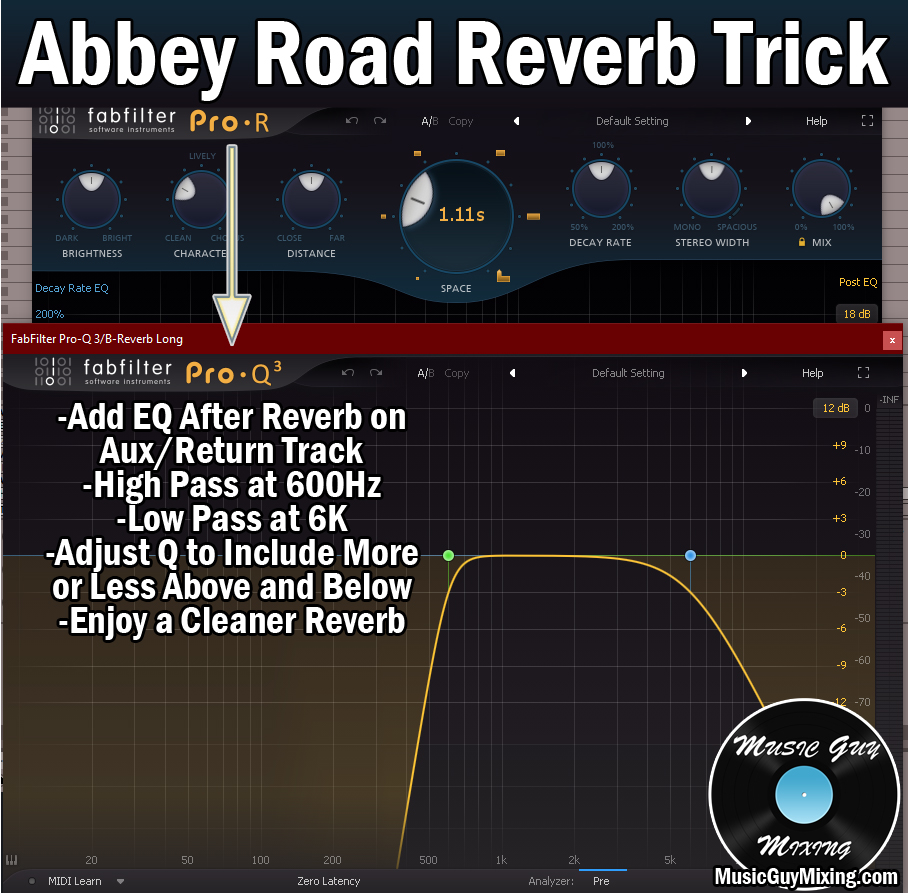I’ve talked about fixes for a harsh mix, but what if your mix falls into the other end of the spectrum: the DULL end. Whenever my mixes sound dull, I turn to these 7 fixes.
My Mixes Sounds Dull – 7 Fixes

Too Much Low End
The low end of your mix is its anchor. It holds your kick which is necessary for establishing the beat, energy, and rhythm. It also contains your bass which adds to that rhythm and represents the underlying notes and key of the song.
In other words, it’s essential that you get your mix’s low end right.
Whether your low end is too weak, too strong, or simply out of balance with too much kick or bass relative to the other, these can all account for different connotations of a dull mix.
Check out my low end mixing tutorial to ensure that your kick and bass are properly EQ’d, compressed, and arguably most importantly working together.
Also make sure that you high pass filter every single track in your mix as every single track in your mix has low end information which doesn’t contribute to that specific track.
Properly EQing every single track in your mix with a high pass filter is one of the keys for creating space for the instruments which need that low end space in your kick and bass.
Furthermore, the unnecessary low end rumble, room sounds, and simply unmusical noise adds up over the course of dozens of tracks, dulling your mix. Filtering this out goes a long way to clean it up, so check out my free EQ cheat sheet for tips on how to properly EQ every track in your mix.
Too Much Body
The body of most tracks resides in that fundamental 100-300Hz range of your mix.
This is an important area for adding warmth to individual tracks in your mix, but similar to having too much low or sub frequency information, this can make your mix low-mid heavy.
This throws off the balance with the upper mids and higher frequencies where we traditionally get a lot of that clarity from.
I mentioned the importance of high pass filtering when talking about the low end. Don’t be afraid to filter higher on certain instruments.
As I allude to in my tutorial on how to EQ electric guitar, I’ll typically filter up to 250Hz if not higher on my electric guitar. In terms of the rhythm section of your mix, (rhythm) guitars and bass work together. Some of the producers and mixing engineers filter a lot of the low mids of the guitar out to feature more of the mids and upper mids of that guitar while the bass exclusively handles the low end.
Not only does this create space for other tracks in your mix, but having the various instruments of your mixes working together like this in terms of frequencies is one of the keys to preventing a dull mix.
Too Much Mud
Arguably one of the biggest reasons your mixes sound dull could be a build up of frequencies in the 400-600Hz section on certain instruments.
Between room reflections and the fact that a lot of instruments just plain sound lifeless in the 500Hz region, this area always needs attention via your EQ.
You might try a dynamic EQ cut at 500Hz with 100Hz on either side with a 3-5dB range and the threshold set so this band gets pulled down 1-2dB on average and hits that max when there’s a spike on a certain note:

This is obviously just a generalized starting point, but I put together an entire guide on how to clean up a muddy mix which may single-handedly resolve your dull mix issue.
This also places a greater emphasis on the remaining frequencies like the mid highs and high frequencies, so you get a livelier mix by way of subtractive EQ.
Too Much Unchecked Reverb
Reverb is an incredibly useful tool to use in mixing. Not only does it create a sense of cohesion between the tracks in our mix, but it allows us to simultaneously add three dimensional depth. This can actually help improve a dull mix when one of the causes of the dullness is frequency conflicts which I alluded to earlier.
When we have too much reverb, and unchecked reverb at that, long reverb tails from too much decay begin to suffocate our transients (more on this in a moment) and create buildups like in that muddy 500Hz area I just covered.
Unless we’re using reverb to create an aesthetic on one track in particular, you should keep the amount you blend in with your return/aux tracks via sends to as little as necessary.
Oftentimes reverb works best when you feel it rather than hear it, and subtlety is key there.
Furthermore, absolutely make sure that you high pass filter out the low end of your reverbs themselves.
Reverb on low frequencies especially clutters up the low mids and creates mud, leading to dullness. This is exactly why a technique known as the Abbey Road Reverb trick has become so popular.

The basic gist is to filter out below 600Hz and above 6000Hz (I like a 24dB/oct slope) to keep your reverb well contained in the upper mids and upper frequencies. This keeps the mids and low end of your mix clean, preventing a dull mix.
If your reverb doesn’t have an onboard EQ, putting the reverb plugin on its own return/aux track allows you to easily follow that reverb plugin with an EQ to filter out the problem frequencies on that reverb.
Don’t leave your decay time too long, either. Setting your reverb decay (using a calculator like this) to match a quarter note of the tempo of your song keeps the reverb tight and ensures that the tail will generally have fully faded out before it can cover up the next “hit” of that track.
Lastly, add a little pre delay on your reverb to create separation between the dry instance of your tracks and the wet reverb you’ve blended in. This helps to maintain the transients which keeps your mix punchy. Speaking of transients…
No Transients
Transients are the high frequency rich aspects of sounds which precede the lows and mid frequencies and hit your ears first. They help a track cut through a dense mix and assert itself.
The example I always use is the snap/crack of stick on skin of a snare drum. That 5k crack cuts through the mix, drawing the ear to that snare as the rest of the sound follows.
Every track in your mix has transients or better said SHOULD have transients, but it’s not a given. Without transient punch, your mix will sound dull.
On the snare in particular, we can boost at that 5k to help a dull snare cut through the mix via transients (as one example):

Also make sure you keep some attack on the compressor of that track to slightly delay the compression and allow the transients to come through unabated for a split second.
Check out my tips on how to add audio transients to every track in your mix, either by bringing out what’s already there or artificially adding them.
Panning Conflicts
I mentioned earlier that one of the keys to preventing a dull mix is essentially avoiding frequency conflicts.
We can use reverb to simulate depth and situate tracks farther back, but one of the keys to fixing a dull mix is to avoid two dimensional panning conflicts.
In other words, if you have two or more tracks which share similar frequency ranges for their fundamentals and overtones, we want to keep them separated in the stereo field.
I put together an entire audio panning guide designed to show some general locations for every track/instrument in your mix which typically work well to create that separation and avoid these conflicts:

Remember that, because you want to keep the kick and bass on top of one another in the center position, you’ll want to sidechain your bass to your kick to help give them each a bit more space even though they share that center position as I cover in my aforementioned low end mixing tutorial.
Add Some Brightness
Sometimes when my mixes sound dull, the most obvious answer is the right one.
For some dull mixes, you just need to add more top end via EQ or higher frequency saturation harmonics in the form of an exciter. I covered this more in depth in my overview of what is saturation.
Sometimes your mix is just a small nudge away from sounding A LOT better and less dull. In this case you might try using some excitation on your master bus processing chain.
I put together an entire overview on how to process your master bus, so refer to that for tips on resolving your dull mix on the most macro level.
While adding harmonics in the 4-7k range will make a big difference, if you find it’s adding an unpleasant harshness, you might try going higher.
The 10-12k range is more about the “air” of your mix and can add some crispness without adding to any frequencies which can irritate your ear.
This is the more conservative and transparent location to boost via an exciter or even a small EQ high shelf on your mix/master bus:

My Mixes Sound Dull Tips
- If your mix is sounding dull, there are a number of things you can try to adjust, add, or subtract to clear or liven up your mix.
- While the low end is an essential component to your mix, too much low end or an unbalanced low end can lead to a dull mix. High pass every track in your mix to create space for the tracks which need it like the kick and bass, as well.
- The body or fundamental frequencies of most tracks creates warmth that we always crave from our mixes, but just like too much low end can dull your mix, so too can too much body. Pay attention to the 150-300Hz region on many of the tracks in your mix and make sure you don’t have too MUCH body or warmth in your overall mix.
- Mix mud builds up in the 400-600Hz region and too much can quickly clog up and dull your mix. Pay attention to this area on every track in your mix when you’re doing your EQ cuts.
- Reverb helps to create depth which is obviously a good thing. Too much reverb blended in with too long of a decay can step on the next note and dull that track, leading to a duller mix. Keep your reverb sizes realistic and relatively small, not to mention use a little pre delay to allow the transients to asser themselves. EQ your reverb to high pass out everything below 600Hz to keep those clean, too.
- Transients are the high frequencies of most of the tracks in your mix which help them punch through. Make sure you use enough attack to allow transients to cut through, or even consider adding to the transients to resolve a dull mix that way.
- Frequency conflicts occur when two or more tracks which share similar fundamental frequencies are panned near or on top of one another. Create separation between similar frequency sharing tracks via panning to create a more open and less dull mix. Additionally, make sure your kick and bass are working together via some sidechaining so that the bass lets the kick breath when it triggers since they both share the center of the mix.
- When all else fails, add some brightness via exciter-type saturation or a small high shelf in the 10-12k of the master bus for some subtle crispness.
